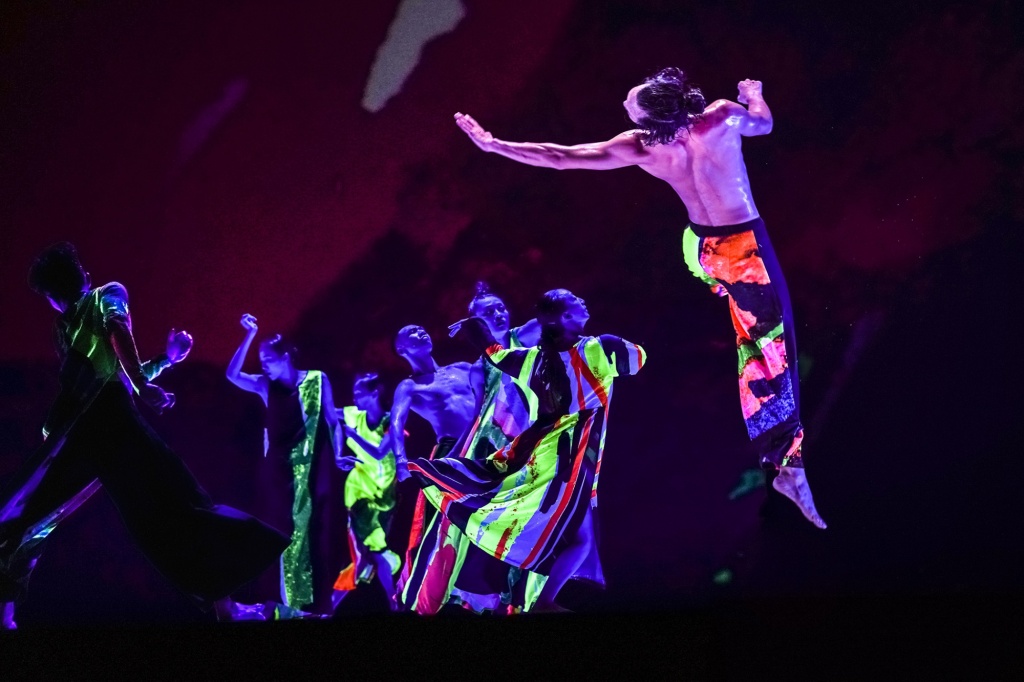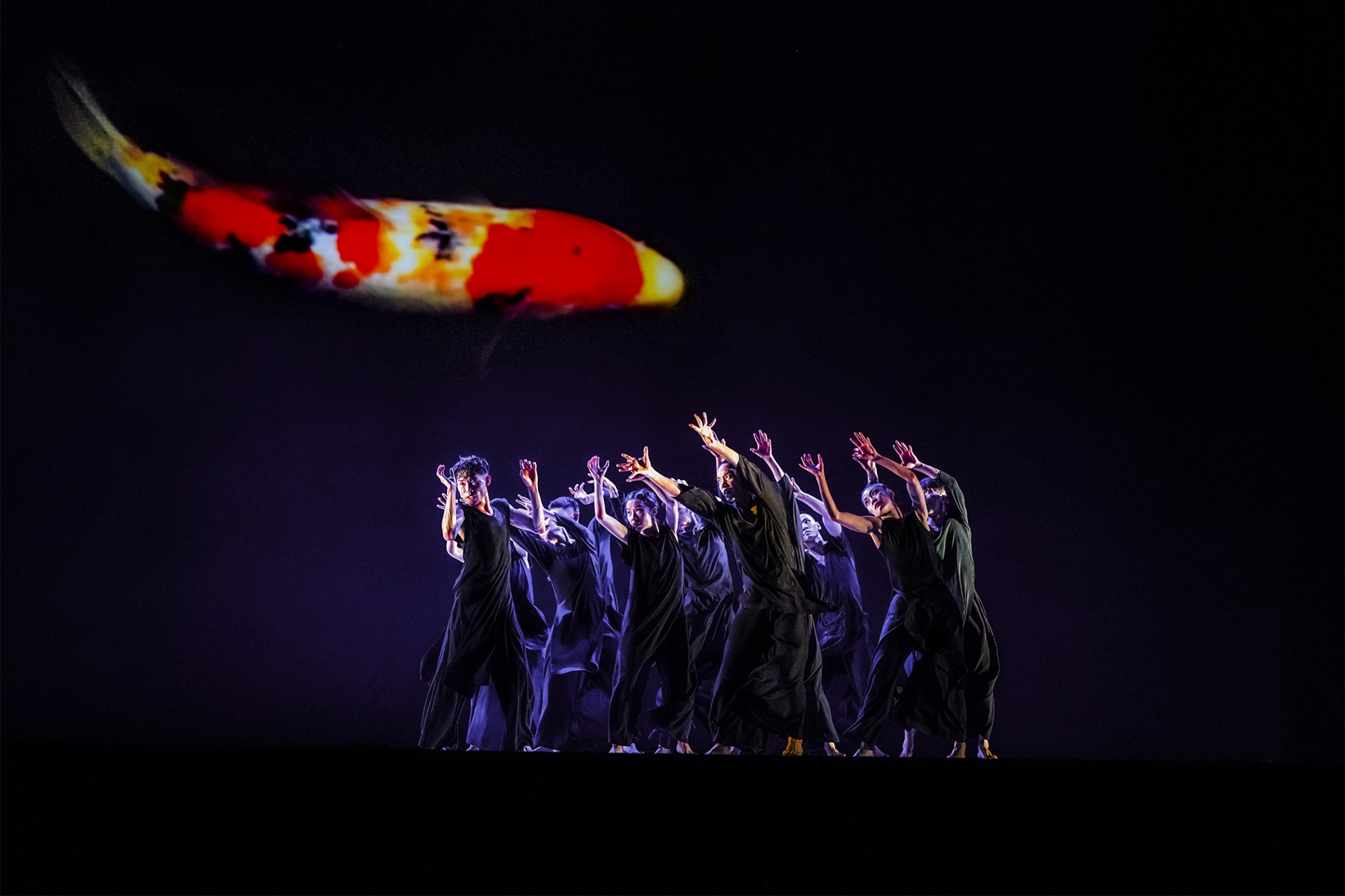Wow! What a night!
From the first ring of a single hand bell that roused the ensemble dancers in black to the final explosion of colors that filled the stage, “Thirteen Tongues” /《十三聲》is a stunning representation of a slice of Taiwan. Created by Cloud Gate Dance Theatre’s new artistic director Tsung-Lung Cheng (鄭宗龍), the production transforms his childhood memory of the sights, sounds, and energy of Bangka—Taipei’s oldest district—into an arresting dance reverie.
The many vibrantly diverse characters making up the different facets of Bangka street scenes were what inspired Cheng to name this production “Thirteen Tongues,” after a legendary street artist and storyteller in the 1960s who has made Bangka his stage. As Cheng’s own mother puts it, the street artist and storyteller told the most exciting and fantastical stories just by using his own voice to create different characters and sounds.
Here’s an expert from the program that describes the street artist and storyteller:
“It was said that “Thirteen Tongues” could conjure up all the Bangka/Wanhua characters—high- and low-born, sacred and profane, men and women—in the most vivid, dramatic, and fluently imaginative narratives.
“Thirteen Tongues” started with dancers dressed in black dancing to somber (alien-sounding even) music. Their bodies moved and flowed, yet in a jarring beautiful way as they also yelled and shouted, making incoherent noises.
These sounds were unpleasant, ugly even. I was startled because based on my past experiences with Cloud Gate performances, I was expecting something more Zen-like.
What’s going on? Are they fighting? How is this Bangka?
Bangka
The official nowadays name for Bangka (艋舺) is Wanhua (萬華). Taiwanese people use Bangka and Wanhua interchangeably because “Bangka” sounds like the Taiwanese Min-Nan dialect (閩南語) pronunciation of “Wanhua.” However, the name Bangka did not come from the Min-Nan dialect, but derives from the Ping-Pu-Zu (平埔族), the Plains Indigenous People of Taiwan. The aboriginal language of Ketagalan (凱達格蘭族語) referred to Bangka as “Mankah/Moungar”, or “the gathering place for canoes.”
Canoes were abundant in Bangka during its early days when the district was a bustling port city serving as an important base for merchants, boatmen, and dock workers. In the Qing Dynasty, the port city ranked among the three major cities in Taiwan, which are listed in the order of Fucheng (府城) in Southern Taiwan, Lukang (鹿港) in Central Taiwan, and Bangka in Northern Taiwan.
Bustling economic activities came with the development of darker, less savory businesses—prostitution and organized crimes (also known as Gatao or gangs) also flourished.
Specifically, I learned from my research that during the 1980s, the time period when Cheng was growing up Bangka, the district had a buzzing red-light district with legal brothels. While prostitution is no longer legal, I wonder if perhaps Bangka’s seedier past has contributed to the dark, disagreeable dance expressions in the beginning of the performance.
After the dark, unpleasant sounds, there was an mantra dance number, evoking images of temple, religion, and spirituality. I immediately thought of Lungshan Temple (龍山寺), a magnificent historical temple in the area that is famous among locals and tourists. A Second-Class National Monument (2 級古蹟), Lungshan Temple is an architectural masterpiece, representing Taiwan’s unique blend of faith that that melds Buddhism, Daoism, and folk religion.
Following the mantra number, a gigantic Koi fish in red-orange, white, and black appeared, swimming in the background. The Koi would disappear and reappear throughout the rest of the performance. I felt like the Koi was carrying me in and out of a dream or spiritual world.

Then, colors were introduced little by little. Slowly, the Cloud Gate that I had been expecting began materializing.
The significant “wow” moment that made the entire night extraordinary was when the neon colors arrived, or what I interpreted as the scene of puppet theater (布袋戲 bu-dai-xi). The dancers, still dressed in black, contrasted to a single figure of color: a puppet-dancer wearing a fluorescent, multi-colored robe. At times, the puppet-dancer appeared to be controlled by a puppet master; she was held and turned in mid-air in a dance lift, limbs locked, unable to move on their own. At others times, the puppet-dancer was a puppet no more. She took on a life of her own—traveling effortlessly across a row of bent-over dancers of varying heights, making the audience forget that there was ever a puppet master.
The effect of the neon, combined with the puppet dancer’s movements traversing between manipulated and free movements, resulted in an effect so magical to behold.
When the Clock Strikes
The puppet show makes up only a slice of Bangka’s street scene, which Cheng says wakes up when night market hour strikes.
I can imagine. While I’ve yet to visit nighttime Bangka, Taiwan’s nightlife is really something to behold.
While watching “Thirteen Tongues,” it didn’t matter that I didn’t fully comprehend the meaning behind every movement or the uttered sounds and Taiwanese lyrics. Once that first “wow” moment took place, my sense of wonder continued. It was as if the colors woke up the piece and filled it with bustling energy and joyous vivacity. That energy held up and climaxed until the final dance number where every dancer donned on an iridescent robe. Moving colors in the background and moving colors on dancers erupted the entire stage triumphantly into a celebration of life in every dimension imaginable.
Hear. Look. Experience
“Thirteen Tongues” is more than just a dance performance, it’s also a spectacular visual and auditory experience. I highly recommend watching the video below that features interviews from Cheng (choreographer), Lim Giong (music), and Ethan Wang (projection design). English subtitles are available.
Learn more about Cloud Gate https://www.cloudgate.org.tw/en/cg/about/cloud-gate



